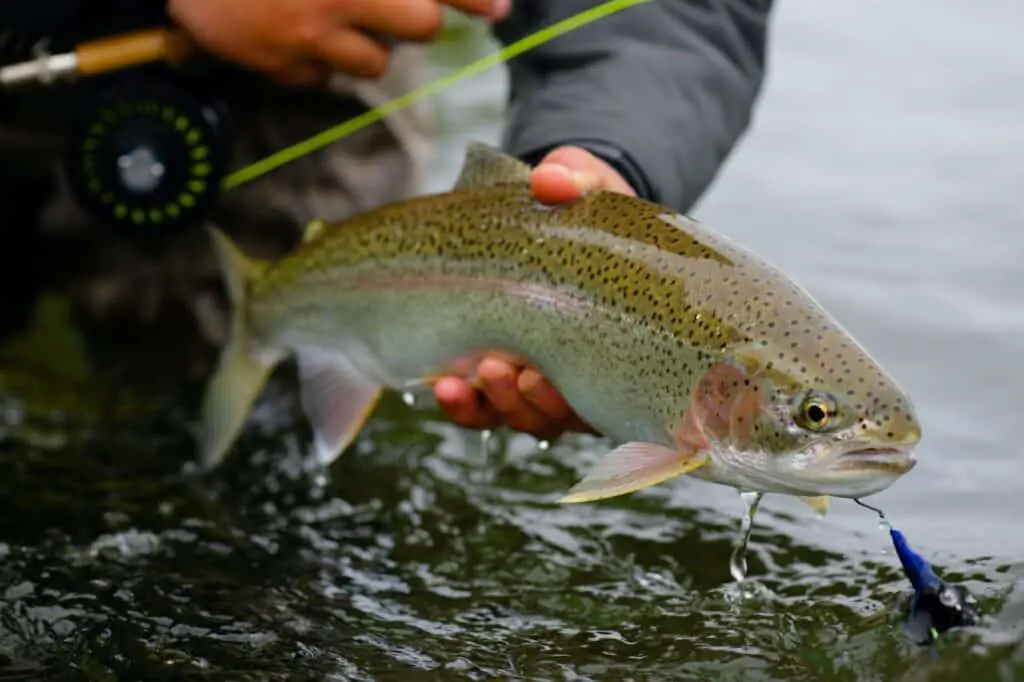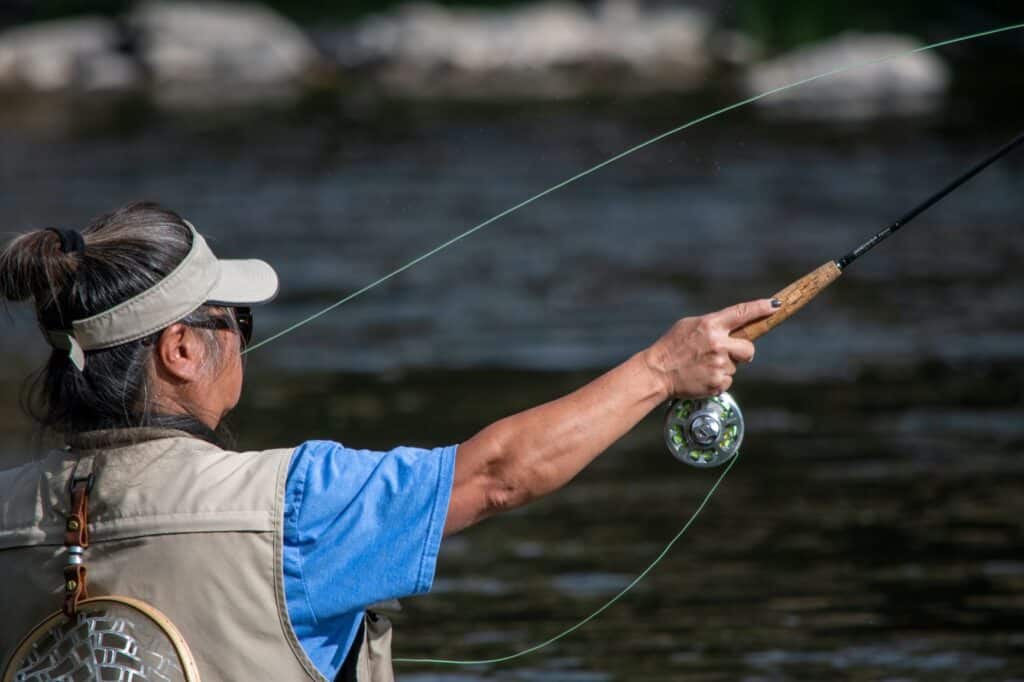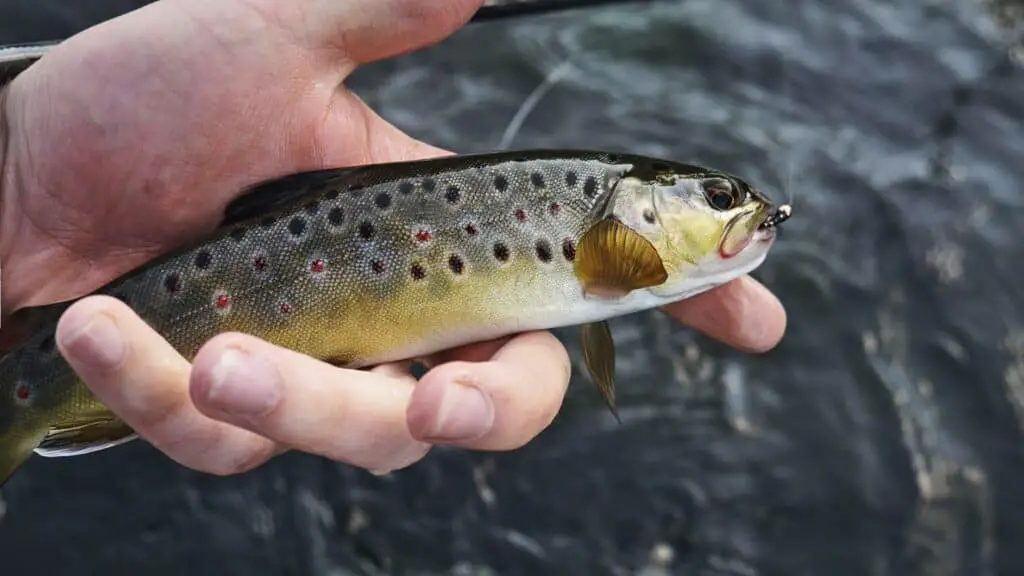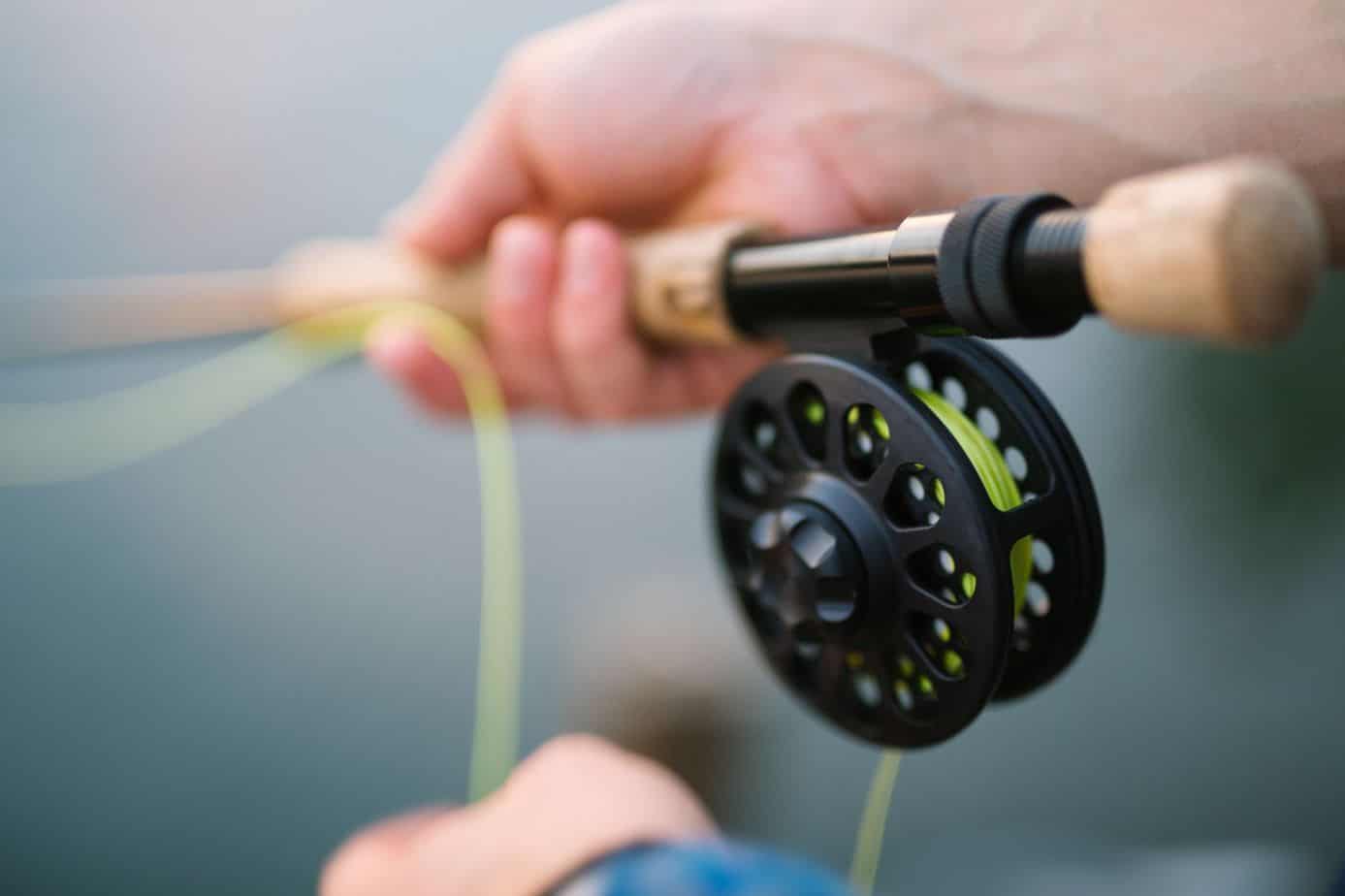In many fishing areas, frequently, there is some gear necessary to catch the fish nibbling on the line. It can seem honorable to do it without any help but putting your angler pride aside and using a valuable tool to help can be the difference-maker.
We are talking about fly fishing indicators. In the fly fishing field of angling, strike indicators are a vital part of nymphing. But what are indicators, and what relationship do they have with fly fishing?
Here is a breakdown of what fly fishing indicators are, what they do, and how to use them in the field.
What Is Fly Fishing With An Indicator?
A fly fishing strike indicator is a floating mechanism that allows you to see when fish are biting. It can be spherical and floats on top of the water. Down below, your nymph will be moving through the water column and enticing fish to bite.
At its simplest, an indicator is a beefed-up bobber. They essentially serve the same purpose, but the marketing is a bit different. You can call them several names; bobbers, floaties, suspends, but in the fly fishing world, they are known as indicators.
Although the idea and purpose are the same, the build is different. When people think of bobbers, they often think of the small, red, and white balls kids use to catch bluegill. These are larger and are used to target much bigger fish.
Fly fishing indicators are essential when nymphing. Because the fly is under the water, you can’t see it getting swallowed like you can when dry fly fishing. Knowing when a fish is biting is far more challenging than it sounds. Often, the bite is so subtle that you can’t feel it before it becomes too late.
A fly fishing indicator will be your “eyes” to what is happening underwater. Are they completely necessary? Probably not, but they are extremely helpful for anglers of all skill levels. Once you become an advanced nymph fisherman, you may not use an indicator, but most anglers do anyway.

How Do You Use A Fly Fishing Bite Indicator?
Using fly fishing bite indicators is relatively simple, but some tips and tricks will help you make the process seamless and effective.
First off, you want to make sure that the size of the indicator you use is appropriate for your situation. For example, if you are in quicker moving water or water with slight waves, you may need a larger indicator. This is because the water can make it harder to see from the shore.
On the flip side, calmer waters usually call for smaller, more subtle indicators. This shouldn’t cause as much of a disturbance, and the water will not be a hindrance to your vision.
Another big tip is to get an indicator that has as little water resistance as possible. If the indicator is too big and bulky, it will drag in the water and put unwanted tension on the rig. This can cause the line to snap or cause the fish to unhook itself.
Sure, certain situations can call for heavier indicators, but it is important to understand when necessary and not. The indicators also need to work with the size of the fly you are using.
Heavier nymphs can require heavier indicators. If you are using a super light nymph, but you have a bulky indicator, there is no balance to your rig.
You also want to find an indicator that catches your eye with ease. There are a variety of colors, and it comes down to whatever your personal preference is. The color doesn’t affect the fish, so it is all about what color pops to you and can be easily seen.
Finally, you need to make sure the strike indicator is rigged up correctly.
How Do You Rig An Indicator For Fly Fishing?
Now that you know a bit more about what bite indicators are for fly fishing, it is time to rig one up for yourself. Rigging it the correct way is the difference-maker between catching that trophy fish or letting it slip through your fingers.
If you want to review nymph rigs, read this, “What Is A Nymphing Rig?“
Your indicator has a very specific spot on the fly fishing rig that makes the entire thing work seamlessly. The bit indicator sits on your leader between the regular fly line and your split shot.
Connecting to your regular fly line, you will tie on a tapered leader. About three feet or so down from the connection point, you will attach the indicator. This is the typical measurement when using a 9-foot leader. If you use longer or shorter ones, you will need to change the indicator spot accordingly.
Most indicators are super easy to attach and adjust. Where you set your indicator also dictates how deep in the water column you want your nymph to go. The higher your rig the indicator is on the leader, the deeper the nymph can fall, and vice versa.
Because it is easy to adjust, indicators are nearly idiot-proof and great tools that are both affordable and simple. However, how they attach varies depending on the specific indicator. This is an important factor to consider when in the market for one.

What Are The Top Strike Indicator Styles?
Many styles, shapes, and materials make up fly fishing bit indicators. Each one has a different purpose than the others. Knowing what kinds will benefit you in certain situations is the key to success. Here are a few types of bite indicators on the market today!
Foam Footballs
One of the most common and popular indicators takes the shape of a foam football. Several perks come with using a foam indicator.

Firstly, they are super easy to install and adjust. You can seamlessly make changes without damaging or imprinting your leader. This is a common problem amongst some indicators because the attachment point can experience some wear and tear. This shortens the life of your leader. Thankfully, this isn’t usually the case with foam footballs.
Another great perk is its buoyancy. Foam balls are densely packed and hold pockets of air well. So, even your heaviest nymph probably won’t take it down. This is important to consider because you want an indicator that can work well with the various nymphs you are throwing.
Where you may want to use a foam football is when you are fishing deep waters. Because the foam football can make a splash, finicky fish in shallow waters can be spooked fairly easily. Although you can get foam indicators of differing sizes, keeping your surroundings in mind is still important.
Plus, these come in sleeves of multiples, so you won’t have to go out and buy more very often.
Cork
One of the first indicators to hit the industry was the cork device. The style is a little bit dated, but you still see some fly fishermen using them. Cork is exceptionally buoyant, which is one of the essential features of this tool.
Cork indicators were around really early because they were affordable, easy to find, and easy to make. Now, technological advances have put these on the back shelf. That doesn’t mean they are worth completely disregarding.

There isn’t one specific condition that causes anglers to use cork indicators, so they are relatively versatile. They can get quite small, so that is a plus when considering having a quiet entry into the water.
You can buy several sizes, and all are affordable because the technology is so cheap.
Sighters
A sighter is a different style of indicator, but it is worth discussing, so you have yet another option on the table. Sighters are not suspension indicators, and they more so serve as an add-on.
This style of an indicator is a colored attachment that goes right on your leader. It will add an extra layer of visibility on top of or in place of a floating indicator.

If you are still starting out, sighters are fantastic to add when you are still using a traditional indicator. This way, you will have maximum visibility. If you are a little more advanced, streamers are great when you want to work yourself away from using floating indicators slowly.
These aren’t for everyone as they do have an impact on your ability to fish. Because it is adding more structure to your leader, long drifts are not ideal with this setup. You can’t have too much slack in your line with a sighter, and they require longer leaders. So, this isn’t the most popular add-on, but it is an option.
The same brands that bring you fly fishing line also produce sighters, so you can stick to supporting your favorite company if you so choose.
Bubble
Bubble rig indicators are the closest you can get to those classic bobbers used in other types of fishing. These aren’t real bubbles that are blown up every time you use them, thanks to technology.

Back in the day, this style of indicator took the shape of a balloon before the new advancements took over. You probably won’t see too many anglers using balloons, but it isn’t completely unheard of.
The first plastic bubble rig that hit the market was the Thingamabobber. This brand changed the game and introduced the industry to this style of indicator that has grown into one of the world’s most popular types.
Now, the balloons are plastic, hollow balls that float very well and can be seen easily. They are also straightforward to attach and adjust. They just clip on to your leader and can be adjusted to make your nymph go deeper or shallower. Keep in mind that this style of indicator can leave an imprint on your leader. So, there is a little bit of damage that can come, so you will have to change your leader more often.
A problem you will have to battle with is the water-entrance and how it can affect the fish. Like some of the other indicators, these can make a significant disturbance when hitting the water. Depending on your specific situation, this may not be a problem, but this is an important factor to keep in mind when in shallow water.
Because these are so cheap to produce and have been refined so much by technology over the years, bubble indicators are some of the most affordable on the market.
Yarn/Wool
The lightest indicators on the market are the yarn or wool variations. There aren’t many fancy names for these as the material you use is what it is normally referred to as. With both the yarn and wool options, there are some great pros and not-so-great cons that come with them.

Some fantastic perks come with using a really light indicator. One of them is that you can land your rig in the water with ease and without spooking fish. If you are in shallow or very clear water, these indicators are perfect for silently entering the water.
This style of indicator is also really easy to see. You can customize the color and make it easy to locate from your casting point.
The way you cast the rig out and retrieve it back in is also improved with a yarn or wool indicator. Because they are ultra-lightweight, you won’t have to adjust your cast to account for extra bulkiness on the rig. When having a fish thrashing on the other side, you won’t have to worry about the indicator getting hung up, putting unneeded pressure on the line, and having high water resistance.
However, it isn’t all good aspects of this indicator, although they are very good. The lightweight is a double-edged sword. Although its weight is great for many aspects, it can hurt you in one way in particular. Using this type of bit indicator restricts what kind of nymph you can use.
These will not work with heavy nymphs because the indicator will be pulled under the water. They are perfect for lightweight nymphs, though.
More specifically, the New Zealand wool rig is quite popular but can get pricey.

Can A Dry Fly Be Used As An Indicator?
Believe it or not, dry flies can serve as indicators when you are in a pinch. Although many fly fishers prefer to use actual indicator add-ons, certain dry flies can take an indicator’s place.
There are some aspects to keep in mind if you are looking to use a dry fly as an indicator. Firstly, you have to keep weight in the back of your head. You need to think about the weight of both the dry fly and the nymph. You will probably need to use one of your heaviest dry flies to stay on top of the water with the nymph.
If your nymph is too heavy and it drags down the dry fly, the whole rig is useless as an indicator when there are bites. So, pick a heavy dry fly and a light nymph for it to work correctly.

A unique perk of using a dry fly as an indicator is that it can be used as a secondary hookup point. Dry flies are the only indicators with hooks. Not only is your nymph below enticing that trophy trout to bite, but you will also have a dry fly on top as another option!
Using a dry fly as an indicator provides a seamless entering of the water and will not spook fish when it hits the surface like other indicators.
If you’re not sure, there are lots of different types of fly fishing flies.
Plus, you won’t have to spend any extra money because you probably already have a dry fly that can work in an indicator’s place. You will save both money and space as you won’t have to worry about a bulk indicator taking up valuable room.
Unlike the other indicators, there is no dry fly part of the market that is specifically engineered for indicating, so you should find a large one that is strong enough to hold up your nymph.
Conclusion
Fly fishing bite indicators aren’t required, but they can add a valuable element to your next time nymphing.
One of the most challenging aspects of learning to fish is figuring out when a fish has committed enough to set the hook and engage in the batter. Fly fishing strike indicators facilitate this issue and help you visualize what you otherwise couldn’t see happening under the water.
Not every fly fisher will think these are necessary, but beginners and experts alike use these to increase their chances of catching that trophy fish. Hopefully, you now know what fly fishing bite indicators are, what instances they are best used, and when some variations can be avoided.
Good luck and happy nymphing!

